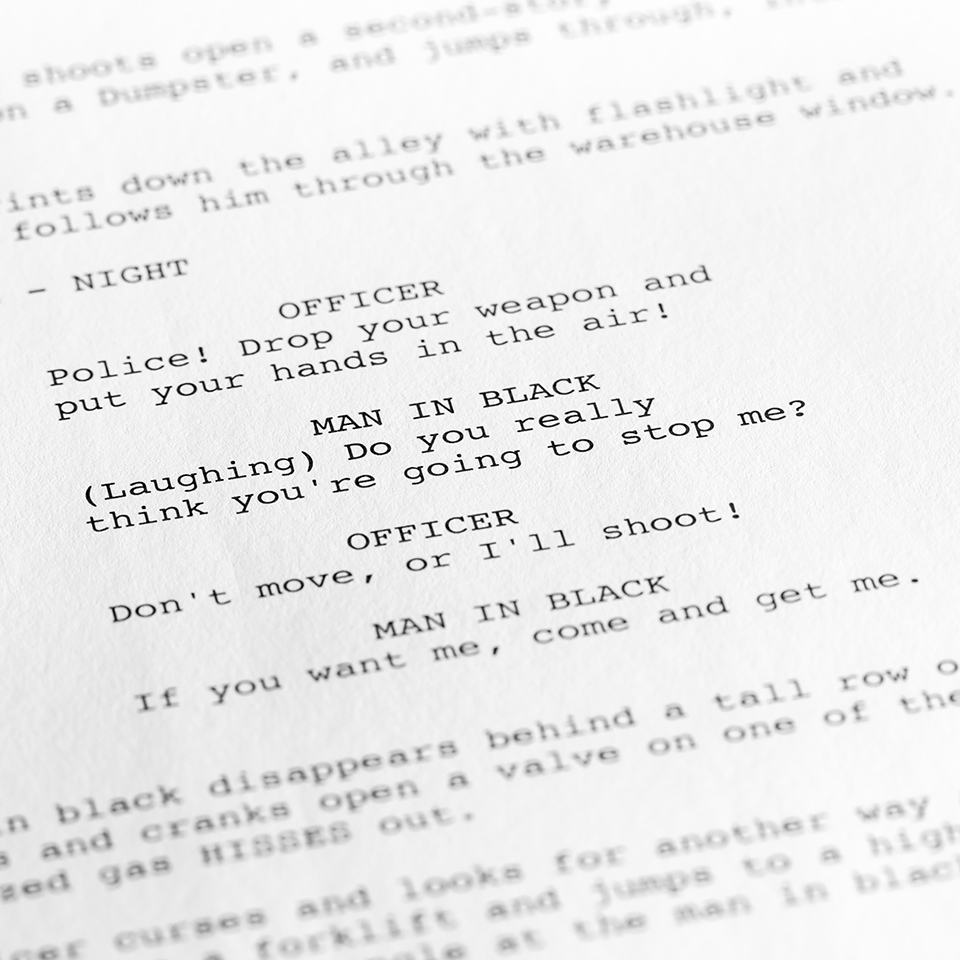If you're a film lover or dream of writing for film or TV one day, screenwriting is a powerful way to bring your stories to life. And our accredited Screenplay Writing Diploma Course is a great place to start your script writing career!

Jump to:
In this guide, we’ll walk you through the screenwriting process, from your first idea to the final script.
Knowing how to write a screenplay is invaluable for storytellers. It helps you create structured, engaging stories that can be adapted for film and TV, reaching millions of viewers. Screenwriting teaches you to think visually and tell your story in a concise, dynamic way. This skill can improve your storytelling and open doors to various opportunities in the entertainment industry.
What is a Screenplay?
A screenplay is a written document that outlines every visual, action, and dialogue element required to tell a story for film or TV. It serves as a blueprint for the production, guiding directors, actors, and crew members in bringing the story to life on screen. Screenplays include scene descriptions, character actions, and dialogue, formatted in a specific way to ensure clarity and ease of use during production.
Key Differences Between Film and TV Scripts
While both film and TV scripts share the same fundamental structure, there are key differences:
- Length and Structure: Film scripts are typically longer, ranging from 90 to 120 pages, and follow a three-act structure. TV scripts vary depending on the format (e.g., half-hour soaps versus hour-long dramas), with episodes usually ranging from 22 to 60 pages. TV scripts are often written with TV breaks in mind, dividing the story into multiple acts.
- Character Development: TV scripts allow for more extended character development over multiple episodes and seasons, whereas film scripts focus on developing characters within the confines of a single story arc.
- Pacing: TV scripts require a faster pace to keep viewers engaged across multiple episodes. Film scripts can afford a more gradual buildup, given the longer runtime.
The Role of a Screenwriter
Writing a script is more than just transferring a great story onto paper. The screenwriter’s role extends beyond this, as they must write the script in industry-standard format, ensuring it’s clear and easily understood by everyone involved in the production. Screenwriters also collaborate closely with directors, producers, and other team members to refine the script and bring the story to life. This often includes revising the script based on feedback to improve the story, dialogue, and overall structure. Through this process, the screenwriter helps shape the vision that will ultimately appear on screen.
Recommended for you!
Best SellersFinding your inspiration and developing the concept
Every great screenplay starts with a spark of inspiration. This can come from anywhere—an interesting news story, a personal experience, a fascinating character, or even a simple “what if” question. Keeping a journal or a digital note where you jot down ideas as they come to you is always a good idea as inspiration can strike at any moment!
Once you have a source of inspiration, the next step is to develop it into a solid concept. This involves defining the core of your story—what it’s about and why it matters. Think about the main characters, the central conflict, and the setting. What are the stakes? What journey will your characters go on?
This stage is about fleshing out the broad aspect of your story and ensuring there is enough substance to build a screenplay around. It can be helpful to write a brief summary or a logline—a one or two-sentence description that captures the essence of your story.
Once you have a solid concept in hand, it’s time to do your research. This might involve studying the time period your story is set in, understanding the profession of your main character, or learning about the real-life events that inspired your plot. Audiences and critics love to point out inaccuracies in a plot, so the best thing you can do is make sure you do your research properly. This phase is all about expanding your initial idea into a rich, detailed blueprint for your screenplay.

Crafting your Story
Before writing your story, it’s important to know the difference between your story and the actual plot. Story refers to the essence of your screenplay—the emotional journey, the character arcs, and the thematic exploration. It’s the heart and soul of your narrative. Plot, on the other hand, is the sequence of events that unfold in your screenplay—the actions, conflicts, and resolutions that drive the story forward.
Creating a logline
A logline is a concise summary of your screenplay that captures its core concept in one or two sentences. It should convey the central conflict, main characters, and stakes of the story, while also intriguing the reader or listener.
Here are a few great examples of loglines from famous movies:
- A seventeen-year-old aristocrat falls in love with a kind but poor artist aboard the luxurious, ill-fated R.M.S. Titanic. - Titanic
- A Christmas Elf goes to New York City in search of his biological father, knowing nothing about life outside of the North Pole. - Elf
- After a bachelor party in Las Vegas, three friends with no memory of the previous night wake up to find the bachelor missing, consequently seeking to find their friend before his wedding - The Hangover
If you plan to pitch your screenplay and generate interest from producers, directors, or potential collaborators, it’s important to write a compelling logline—as this is the first insight they will have into your story.
Structure and Format
The Three-Act Structure
The three-act structure is a classic narrative framework used in screenwriting to organise the story into three distinct parts: the setup, the confrontation, and the resolution. It’s not essential to follow this exact structure to have a successful screenplay, but it is a great starting point. In fact, you’d be surprised how many films, whether they’re blockbuster action films or drama indie films, tend to follow the same three-act structure.
Act 1: The Setup
- Introduces the main characters, the setting, and the central conflict.
- Establishes the stakes and hooks the audience.
- Typically ends with an inciting incident that propels the protagonist into the main action of the story.
Act 2: The confrontation
- The protagonist faces a series of escalating obstacles and challenges.
- Develops subplots and deepens character relationships.
- Often includes a midpoint, where the stakes are raised or a significant twist occurs.
- Culminates in a crisis or major setback that leads to the climax.
Act 3: The Resolution
- The climax, where the protagonist confronts the central conflict head-on.
- The resolution, where the story's conflicts are resolved, and the characters' arcs are completed.
- Concludes with tying up loose ends and providing closure.
Beat Sheets
A beat sheet is a detailed outline that breaks down the screenplay into key moments or "beats" that drive the narrative forward. Each beat represents a significant plot point or emotional turning point in the story. Screenwriters use a beat sheet to make sure the screenplay maintains a consistent pace and structure.
Key plot points typically included in a beat sheet are:
- Opening Image: A visual that sets the tone of the story.
- Inciting Incident: An event that disrupts the protagonist's ordinary world.
- Midpoint: A pivotal moment that changes the direction of the story.
- Crisis: The protagonist's lowest point or a significant challenge.
- Climax: The final confrontation or peak of the story’s conflict.
- Resolution: The aftermath and conclusion of the story.
Formatting your script to industry standards
All scripts must follow industry standards. Proper formatting is required to ensure that they’re professional and easy to read.
- Font and Spacing: Use 12-point Courier font with 1.5-inch left margin, 1-inch right margin, and single-spaced text.
- Title Page: Includes the title, your name, and contact information.
- Scene Headings (Sluglines): Indicate the location and time of each scene, formatted as "INT./EXT. LOCATION - DAY/NIGHT."
- Action Lines: Describe the setting, character actions, and events, written in the present tense.
- Character Names: Centred and capitalised above dialogue lines.
- Dialogue: Centred text that follows the character’s name, representing what they say.
- Parentheticals: Brief directions within dialogue, indicating how a line should be delivered or what a character is doing.
- Transitions: Placed on the right margin to indicate scene changes, such as "CUT TO:" or "FADE IN:"

Character Development
Compelling characters are at the heart of a great story. Your characters should be well-rounded and multidimensional, with distinct personalities, desires, and flaws.
Here are a few things to consider when developing your characters:
What is their background and motivation? Give your characters detailed backstories and clear motivations. Understanding their past experiences and what drives them will make their actions and decisions more believable.
What are their strengths and their flaws? Well-rounded characters have both strengths and weaknesses. Flaws make characters relatable and provide opportunities for growth and conflict within the story.
How do they speak? To make the dialogue feel more authentic, consider how your character speaks. Ideally, this should reflect their background and personality.
Once you’ve established your characters, consider how your characters will develop throughout the story - this is known as the character arc. Effective character arcs are essential for engaging storytelling because they show how characters evolve in response to the events of the plot.
First, establish your character’s initial situation and mindset. This is where their journey begins. As your character faces obstacles that challenge their beliefs, strengths or flaws, they should develop as an individual. These obstacles should push them towards change. Finally, the climax in the third act usually represents the peak of the character’s arc, where they must confront their greatest challenge. The resolution shows the result of their journey, whether it’s growth, failure, or transformation.

Writing the Screenplay
It’s almost time to start writing - but first it’s essential you start with an outline in note format to serve as a roadmap for your story.
To do this, you’ll need to do the following:
- Break down the three-act structure: Divide your story into three acts, outlining the key events and turning points in each act.
- Detail major plot points: Including the inciting incident, midpoint, climax, and resolution.
- Character Arcs: Map out the arcs for your main characters, noting how they evolve throughout the story.
- Scene Summaries: Write brief summaries of each scene, focusing on what happens, which characters are involved, and the scene’s purpose.
Scene structure and writing effective scenes
Each scene in your screenplay should serve a purpose and move the story forward. Even those small scenes in feature films that seem “boring” are actually well thought out and add to the overall story, whether you realise it at the time or not!
Here are some key things to consider when writing your scenes:
Purpose
Every scene needs to have a clear purpose, whether it’s advancing the plot, developing a character, or establishing the setting.
Beginning, Middle, and End
Structure each scene with a clear beginning, middle, and end. Start with an engaging hook, build tension or conflict in the middle, and conclude with a resolution or cliffhanger.
Conflict and Tension
Incorporate conflict or tension to keep the scene dynamic and interesting. This can be external (between characters) or internal (within a character).
Show, Don’t Tell
Use visual storytelling to show emotions, actions, and events rather than relying on exposition. Strong visuals make your screenplay more cinematic. For example, avoid directly stating how your character is feeling and instead allow what’s happening in the scene to tell the audience what they’re feeling instead.
Common mistakes to avoid
Writing a script can be incredibly enjoyable, especially as you immerse yourself in your story, but it's easy to fall into common pitfalls.
Here are a few common mistakes you should try to avoid:
- Overloading with exposition
Exposition is necessary, but too much can bog down your screenplay and make it feel unnatural. Avoid dumping information all at once. Instead, reveal details gradually through dialogue and actions. This way the audience is given the opportunity to piece together the story naturally.
- Weak characters
Characters who are one-dimensional or lack clear motivations can make your story less engaging. When writing their dialogue and actions, remember to consider their personalities and backstories. What motivations drive their actions and decisions throughout the story?
- Not enough conflict
A good story doesn’t always need a huge revenge story or a large battle to conquer, but it does need some level of conflict, for example, difficult family relationships or internal conflict within the main character. Conflict drives your story forward and without it, the plot can feel stagnant and uninteresting.
- Ignoring pacing
A script that moves too slowly can lose the audience’s attention, while one that moves too fast can be confusing. Therefore, you need to balance your action and dialogue, vary your scene lengths and ensure that each scene has a purpose that contributes to the overall story.
- On the nose dialogue
On-the-nose dialogue occurs when characters say exactly what they’re thinking or feeling, leaving no room for subtext or audience interpretation. Your dialogue should sound natural and leave some things unsaid. Instead, use subtext to add depth and complexity to conversations.
Writing a screenplay is an exciting journey that takes patience, creativity, and a willingness to keep learning. If you’re ready to refine your skills, check out our accredited Screenplay Writing Diploma Course for just £29 (save £98!). Our course covers all the topics we've discussed here in greater detail and includes a special module on how to edit and pitch your script to producers!













